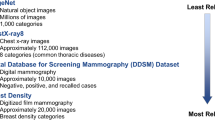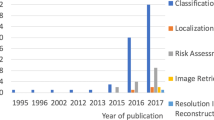Abstract
In order to effectively aid in the automatic classification of the breast cancer suspicious region, a new deep-learning (DL) model built on the transfer-learning (TL) technique is proposed in this work. Pretrained convolutional neural networks (CNN) architectures, such as VGG-16, ResNet-50, Inception-V3, and Efficientnet-B7 are used in the proposed model to extract the features from the MIAS and CBIS-DDSM datasets. Three scenarios are used to evaluate the performance of each network under consideration: TL for the original dataset, TL for the pre-processed dataset, and a novel approach of TL with test time augmentation (TTA). Concerning limited training datasets, the proposed approach showed that pre-trained classification networks with test time augmentation are much more effective and efficient, making them more acceptable for medical imaging. With accuracy (99.97%), specificity (99.24%), sensitivity (98.50%), and F1-score (98.74%), the proposed test time augmentation strategy with transfer learning outperforms other state-of-the-art methods on the MIAS dataset. The proposed model could also do well on the CBIS-DDSM dataset with accuracy (99.8%), specificity (95.44%), sensitivity (96.57%), and F1-score (97.22%). Additionally, on the mammography predictions provided by our algorithm, we also sought the advice of a radiology professional. The model’s predictions and the expert’s assessment are almost in sync.




















Similar content being viewed by others
Abbreviations
- DL:
-
Deep learning
- TL:
-
Transfer learning
- TTA:
-
Test time augmentation
- CADD:
-
Computer-assisted detection and diagnosis
- CAD:
-
Computer aided diagnosis
- DCNN:
-
Deep convolutional neural network
- CNN:
-
Convolutional neural network
- FC:
-
Fully connected
- MBConv:
-
Mobile inverted bottleneck convolution
- CLAHE:
-
Contrast limited adaptive histogram equalization
- FLOP:
-
Floating point operation
- RoI:
-
Region of interest
- ANOVA:
-
Analysis of variance
- HSD:
-
Honestly significantly differenced
References
Cancer Facts and Figures 2021. https://www.cancer.org/research/cancer-facts-statistics/all-cancer-facts-figures/cancer-facts-figures-2021.html. Accessed 31 Mar 2022 (2021)
Mehrotra R, Yadav K (2022) Breast cancer in india: present scenario and the challenges ahead. World J Clin Oncol 13(3):209
Alarming facts about breast cancer in India. https://www.oncostem.com/blog/alarming-facts-about-breast-cancer-in-india. Accessed 26 Mar 2022 (2019)
Bray F, Ferlay J, Soerjomataram I, Siegel RL, Torre LA, Jemal A (2018) Global cancer statistics 2018: Globocan estimates of incidence and mortality worldwide for 36 cancers in 185 countries. CA Cancer J Clin 68(6):394–424
Oza P, Sharma P, Patel S (2021) Machine learning applications for computer-aided medical diagnostics. In: Proceedings of second international conference on computing, communications, and cyber-security, pp 377–392 (2021). Springer
Oza P, Sharma P, Patel S (2022) A drive through computer-aided diagnosis of breast cancer: a comprehensive study of clinical and technical aspects. Recent Innov Comput 1:233–249
Pillai R, Oza P, Sharma P (2020) Review of machine learning techniques in health care. In: Proceedings of ICRIC 2019, pp 103–111. Springer
Tsochatzidis L, Costaridou L, Pratikakis I (2019) Deep learning for breast cancer diagnosis from mammograms-a comparative study. J Imaging 5(3):37
Krizhevsky, A., Sutskever, I., Hinton, G.E.: Imagenet classification with deep convolutional neural networks. Adv Neural Inf Process Syst 25 (2012)
Simonyan K, Zisserman A (2014) Very deep convolutional networks for large-scale image recognition. arXiv preprint arXiv:1409.1556
He K, Zhang X, Ren S, Sun J (2016) Deep residual learning for image recognition. In: Proceedings of the IEEE conference on computer vision and pattern recognition, pp 770–778 (2016)
Tan M, Le Q (2019) Efficientnet: rethinking model scaling for convolutional neural networks. In: International conference on machine learning, pp 6105–6114. PMLR
Szegedy C, Liu W, Jia Y, Sermanet P, Reed S, Anguelov D, Erhan D, Vanhoucke V, Rabinovich A (2015) Going deeper with convolutions. In: Proceedings of the IEEE conference on computer vision and pattern recognition, pp 1–9 (2015)
Oza P, Sharma P, Patel S, Bruno A (2021) A bottom-up review of image analysis methods for suspicious region detection in mammograms. J Imaging. https://doi.org/10.3390/jimaging7090190
Wang G, Li W, Aertsen M, Deprest J, Ourselin S, Vercauteren T (2019) Aleatoric uncertainty estimation with test-time augmentation for medical image segmentation with convolutional neural networks. Neurocomputing 338:34–45
Oza P, Sharma P, Patel S, Kumar P (2022) Deep convolutional neural networks for computer-aided breast cancer diagnostic: a survey. Neural Comput Appl 34:1815–1836. https://doi.org/10.1007/s00521-021-06804-y
Guan S, Loew M (2017) Breast cancer detection using transfer learning in convolutional neural networks. In: 2017 IEEE applied imagery pattern recognition workshop (AIPR), pp 1–8. IEEE
Altaf MM (2021) A hybrid deep learning model for breast cancer diagnosis based on transfer learning and pulse-coupled neural networks. Math Biosci Eng 18(5):5029–5046
Alruwaili M, Gouda W (2022) Automated breast cancer detection models based on transfer learning. Sensors 22(3):876
Sha Z, Hu L, Rouyendegh BD (2020) Deep learning and optimization algorithms for automatic breast cancer detection. Int J Imaging Syst Technol 30(2):495–506
Saber A, Sakr M, Abo-Seida OM, Keshk A, Chen H (2021) A novel deep-learning model for automatic detection and classification of breast cancer using the transfer-learning technique. IEEE Access 9:71194–71209
Carneiro G, Nascimento J, Bradley AP (2015) Unregistered multiview mammogram analysis with pre-trained deep learning models. In: International conference on medical image computing and computer-assisted intervention, pp 652–660. Springer
Shams S, Platania R, Zhang J, Kim J, Lee K, Park SJ (2018) Deep generative breast cancer screening and diagnosis. In: International conference on medical image computing and computer-assisted intervention, pp 859–867. Springer
Jabeen KEA (2023) Bc2netrf: breast cancer classification from mammogram images using enhanced deep learning features and equilibrium-jaya controlled regula falsi-based features selection. Diagnostics 13(7):1238
Atban F, Ekinci E, Garip Z (2023) Traditional machine learning algorithms for breast cancer image classification with optimized deep features. Biomed Signal Process Control 81:104534
Pereira JMS, de Santana MA, de Lima CL, de Lima RdCF., de Lima SML, dos Santos WP (2023) Feature selection based on dialectical optimization algorithm for breast lesion classification in thermographic images. In: Research anthology on medical informatics in breast and cervical cancer, pp 96–119. IGI Global (2023)
Oza P, Sharma P, Patel S (2023) Deep ensemble transfer learning-based framework for mammographic image classification. J Supercomput 79(7):8048–8069
Hamidinekoo A, Denton E, Rampun A, Honnor K, Zwiggelaar R (2018) Deep learning in mammography and breast histology, an overview and future trends. Med Image Anal 47:45–67
Oza P, Shah Y, Vegda M (2022) A comprehensive study of mammogram classification techniques. In: Tracking and preventing diseases with artificial intelligence, pp 217–238. Springer (2022)
Arevalo J, González FA, Ramos-Pollán R, Oliveira JL, Lopez MAG (2016) Representation learning for mammography mass lesion classification with convolutional neural networks. Comput Methods Programs Biomed 127:248–257
Huynh BQ, Li H, Giger ML (2016) Digital mammographic tumor classification using transfer learning from deep convolutional neural networks. J Med Imaging 3(3):034501
Lévy D, Jain A (2016) Breast mass classification from mammograms using deep convolutional neural networks. arXiv preprint arXiv:1612.00542
Oza P, Sharma P, Patel S (2022) Transfer learning assisted classification of artefacts removed and contrast improved digital mammograms. Scalable Comput Pract Exp 23(3):115–127
Oza P, Sharma P, Patel S (2022) A transfer representation learning approach for breast cancer diagnosis from mammograms using efficientnet models. Scalable Comput Pract Exp 23(2):51–58
Khan S, Islam N, Jan Z, Din IU, Rodrigues JJC (2019) A novel deep learning based framework for the detection and classification of breast cancer using transfer learning. Pattern Recog Lett 125:1–6
Agarwal R, Díaz O, Yap MH, Llado X, Marti R (2020) Deep learning for mass detection in full field digital mammograms. Comput Biol Med 121:103774
Vedalankar AV, Gupta SS, Manthalkar RR (2021) Addressing architectural distortion in mammogram using alexnet and support vector machine. Inform Med Unlocked 23:100551
Kim I, Kim Y, Kim S (2020) Learning loss for test-time augmentation. Adv Neural Inf Process Syst 33:4163–4174
Ronneberger O, Fischer P, Brox T (2015) U-net: convolutional networks for biomedical image segmentation. In: International conference on medical image computing and computer-assisted intervention, pp 234–241. Springer
Isensee F, Petersen J, Klein A, Zimmerer D, Jaeger PF, Kohl S, Wasserthal J, Koehler G, Norajitra T, Wirkert S et al (2018) nnu-net: self-adapting framework for u-net-based medical image segmentation. arXiv preprint arXiv:1809.10486
Pang T, Xu K, Zhu J (2019) Mixup inference: better exploiting mixup to defend adversarial attacks. arXiv preprint arXiv:1909.11515
Suckling J, Parker J, Dance D, Astley S, Hutt I, Boggis C, Ricketts I, Stamatakis E, Cerneaz N, Kok S, et al (2015) Mammographic image analysis society (mias) database v1. 21
Lee RS, Gimenez F, Hoogi A, Miyake KK, Gorovoy M, Rubin DL (2017) A curated mammography data set for use in computer-aided detection and diagnosis research. Sci Data 4(1):1–9
Heath M, Bowyer K, Kopans D, Kegelmeyer P, Moore R, Chang K, Munishkumaran S (1998) Current status of the digital database for screening mammography. In: Digital mammography, pp 457–460. Springer
He K, Sun J (2015) Convolutional neural networks at constrained time cost. In: Proceedings of the IEEE conference on computer vision and pattern recognition, pp 5353–5360 (2015)
Srivastava RK, Greff K, Schmidhuber J (2015) Highway networks. arXiv preprint arXiv:1505.00387
Sandler M, Howard A, Zhu M, Zhmoginov A, Chen LC (2018) Mobilenetv2: inverted residuals and linear bottlenecks. In: Proceedings of the IEEE conference on computer vision and pattern recognition, pp 4510–4520 (2018)
Oza P, Sharma P, Patel S, Adedoyin F, Bruno A (2022) Image augmentation techniques for mammogram analysis. J Imaging. https://doi.org/10.3390/jimaging8050141
Gu K, Zhai G, Lin W, Liu M (2015) The analysis of image contrast: from quality assessment to automatic enhancement. IEEE Trans Cybern 46(1):284–297
Xing H, Xiao Z, Qu R, Zhu Z, Zhao B (2022) An efficient federated distillation learning system for multitask time series classification. IEEE Trans Instrum Meas 71:1–12
Xing H, Xiao Z, Zhan D, Luo S, Dai P, Li K (2022) Selfmatch: robust semisupervised time-series classification with self-distillation. Int J Intell Syst 37(11):8583–8610
Acknowledgements
The authors thank Dr. Rajiv Oza (Consultant Radiologist) for helping them validate the model prediction findings. The authors also thank Department of Computer Science and Engineering, Nirma University, Ahmedabad, for providing computing facilities to carry out this work.
Author information
Authors and Affiliations
Corresponding author
Additional information
Publisher's Note
Springer Nature remains neutral with regard to jurisdictional claims in published maps and institutional affiliations.
Rights and permissions
Springer Nature or its licensor (e.g. a society or other partner) holds exclusive rights to this article under a publishing agreement with the author(s) or other rightsholder(s); author self-archiving of the accepted manuscript version of this article is solely governed by the terms of such publishing agreement and applicable law.
About this article
Cite this article
Oza, P., Sharma, P. & Patel, S. Breast lesion classification from mammograms using deep neural network and test-time augmentation. Neural Comput & Applic 36, 2101–2117 (2024). https://doi.org/10.1007/s00521-023-09165-w
Received:
Accepted:
Published:
Issue Date:
DOI: https://doi.org/10.1007/s00521-023-09165-w




